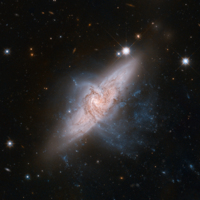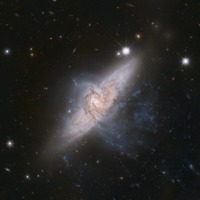Chance Alignment Between Galaxies Mimics a Cosmic Collision
Dublin Core
Title
Subject
Description
NASA's Hubble Space Telescope shows a rare view of a pair of overlapping galaxies, called NGC 3314. The two galaxies look as if they are colliding, but they are actually separated by tens of millions of light-years, or about ten times the distance between our Milky Way and the neighboring Andromeda galaxy. The chance alignment of the two galaxies, as seen from Earth, gives a unique look at the silhouetted spiral arms in the closer face-on spiral, NGC 3314A.
The motion of the two galaxies indicates that they are both relatively undisturbed and that they are moving in markedly different directions. This indicates they are not on any collision course. NGC 3314A's warped shape is likely due to an encounter with another nearby galaxy, perhaps the large spiral galaxy NGC 3312 (located outside the Hubble image).
Because of the alignment, NGC 3314B's dust lanes appear lighter than those of NGC 3314A. This is not because that galaxy lacks dust, but rather because its dust lanes are lightened by the bright fog of stars in the foreground. NGC 3314A's dust, in contrast, is backlit by the stars of NGC 3314B, silhouetting them against the bright background.
The color composite was produced from exposures taken in blue and red light with Hubble's Advanced Camera for Surveys. The pair of galaxies lie roughly 140 million light-years from Earth, in the direction of the southern hemisphere constellation Hydra.
ABOUT THE OBJECT
Object Name:
NGC 3314, NGC 3314A, NGC 3314B
Object Description:
Aligned Galaxies
Object Position:
R. A. 10h 37m 13.0s
Dec. -27° 41' 4.0"
Constellation:
Hydra
Distance:
The distance to NGC 3314A is roughly 117 million light-years (35 Mpc).The distance to NGC 3314B is roughly 140 million light-years (42 Mpc).

